CLIO Talks Back
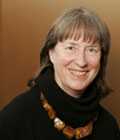
Karen Offen
United States
Archive
- Jun 2011
- May 2011
- Apr 2011
- Mar 2011
- Feb 2011
- Jan 2011
- Dec 2010
- Nov 2010
- Oct 2010
- Sep 2010
- May 2010
- Apr 2010
- Mar 2010
- Feb 2010
- Jan 2010
- Nov 2009
- Oct 2009
- Aug 2009
- Jul 2009
- Jun 2009
- May 2009
- Apr 2009
- Mar 2009
- Feb 2009
- Jan 2009
- Dec 2008
- Nov 2008
- Oct 2008
- Sep 2008
- Aug 2008
- Jul 2008
- Jun 2008
- May 2008
- Apr 2008
I.M.O.W.'s debut blog, Clio Talks Back, will change the way you think about women throughout history! Be informed and transformed by Clio Talks Back, written by the museum's resident historian Karen Offen.
Inspired by Clio, the Greek muse of History, and the museum's global online exhibitions Economica and Women, Power and Politics, Karen takes readers on a journey through time and place where women have shaped and changed our world. You will build your repertoire of rare trivia and conversation starters and occasionally hear from guest bloggers including everyone from leading historians in the field to the historical women themselves.
Read the entries, post a comment, and be inspired to create your own legacies to transform our world.
Clio Visits the Sewall-Belmont House & Museum, Washington, D. C. (USA)
2008-08-25 17:30:06.000
Speaking of museums that tell the stories of politically-active women, Clio reminisces about her recent visit to the Sewall-Belmont House & Museum in the capital city of the United States of America.
August 26 is Women?s Equality Day in the U.S., commemorating the ratification of the Nineteenth Amendment to the U.S. Constitution ? the federal amendment that granted full suffrage to all American women. Today American women will also celebrate the campaign of Hillary Rodham Clinton for president of the United States. Eighteen million persons, women and men, voted for her in state primary elections ? and as Hillary remarked, there are at least eighteen million cracks in the political glass ceiling. But the state-by-state primary election system leading up political party nominating conventions remains rigidly in place.
Prior to the decision to work for a constitutional amendment, the American suffrage leaders had also been campaigning state-by-state. [See Clio?s earlier May blog on Carrie Chapman Catt for her summary of the number of separate campaigns this approach entailed]. Some western states had enacted women?s suffrage on their own, from Wyoming Territory in 1869 (statehood in 1890) to California in 1911. But suffrage advocates had faced rejection after rejection in states further to the east.
A change in tactics seemed essential. Carrie Chapman Catt pushed through the idea of pursuing a constitutional amendment as a far more efficient means of achieving the goal. The text submitted and finally ratified is: ?The right of citizens of the United States to vote shall not be denied or abridged by the United States or by any state on account of sex.?
With the help of the wealthy Alva Belmont, women of the National Woman?s Party including Alice Paul, who spearheaded the militant campaign that ultimately provoked congressional passage of the Nineteenth Amendment, established their headquarters in this lovely house, near the U.S. Supreme Court and Capitol, and the several congressional office buildings. The house, finally purchased by the NWP in 1929, was designated a National Historic Landmark in 1974. Inside is a remarkable museum, containing furniture, art, and artifacts from the period of the suffrage struggle as well as the archive of the NWP. The house has recently been renovated, inside and out and the project to digitize materials in the archive is underway.
Clio was impressed by the quality of the museum?s presentation, including the video of the suffrage movement. She could sense the energy and vitality that these young American suffragettes exuded as they planned their campaigns to picket the White House and to defy their jailers after being arrested. Much of this story has been captured by the recent HBO film ?Iron-Jawed Angels,? which is a must-see film for those who know little about the drama of the fight for the vote.
For additional information on the Sewall-Belmont House and the National Woman?s Party, Clio suggests consulting the website at www.sewallbelmont.org
PERSPECTIVES ON WOMEN?S SUFFRAGE IN THE WESTERN WORLD, 1780s-1990s
2008-08-23 12:11:45.000
On August 26 women in the United States celebrate Women's Equality Day, commemorating the day on which women's vote received constitutional ratification.
Clio reminds viewers that in many countries throughout the western world women and some men insisted that women should vote and thereby exercise full citizenship.
Here are some of those voices, beginning in the 1780s in France:
?Is it not as sentient beings, capable of reason, having moral ideas, that men have rights? Then women should have exactly the same rights, and yet never, under any free constitution, have women exercised the right of citizenship. . . . The facts prove that men have or believe they have interests that are very different than those of women, because everywhere they have made oppressive laws against them, or at least have established a great inequality between the two sexes.?
The marquis de Condorcet (France, 1787)
?The representatives should have absolutely the same interests as those represented; therefore women should only be represented by women.... Why is it that the law is not the same for both? Why does one sex have everything and the other nothing??
Madame B*** B*** (France, 1789)
?...it is a duty imperative upon her to deliberate with man in all affairs of government, for with man she has a concurrent jurisdiction over the things of the earth.?
R. J. Richardson (England, 1840)
?We are aware that it is said, that woman is virtually represented in Parliament, her interests being the same as those of man; but the many laws, which have been obliged to be passed to protect them from their nearest male relatives, are a sufficient answer.... They are evidently the production of men legislating for their own most obvious interests ... without the slightest reference to the injustice they were committing against women.?
Marion Kirkland Reid (England, 1843)
?Citoyennes, it is as Christians and mothers that women must demand the rank that belongs to them in the church, the state, and the family.... It is especially this sacred function as mother, which some insist is incompatible with the exercise of a citizen?s rights, that imposes on woman the duty of watching over the future of her children and confers on her the right to intervene in all the activities not only of civil life but of political life as well.?
Jeanne Deroin (France, 1849)
?... it is not only the general principles of justice that are infringed, or at least set aside, by the exclusion of women, merely as women, from any share in the representation; that exclusion is also repugnant to the particular principles of the British Constitution. It violates one of the oldest of our constitutional maxims ... that taxation and representation should be co-extensive. Do not women pay taxes??
John Stuart Mill (England, 1867)
?How long are women to remain a wholly unrepresented body of the people? This is a question that has of late been agitated in England, and women in this colony read, watch, and reflect.... Why should not New Zealand also lead?... Why has a woman no power to vote, no right to vote, when she happens to possess all the requisites which legally qualify a man for that right??
Femmina [Mary Muller] (New Zealand, 1869)
?Because man and woman are the complement of one another, we need woman?s thought in national affairs to make a safe and stable government.... Whither is a nation tending when brains count for less than bullion, and clowns make laws for queens??
Elizabeth Cady Stanton (USA, 1869)
?For me the beginning of all true progress in the woman question lies in women?s right to vote.... The stronger the emphasis on the difference between the sexes, the clearer the need for the specific representation of women.?
Hedwig Dohm (Germany, 1873)
?...a suffrage that allows you to exclude from the electoral lists nine million women is far too restrictive to bear the name universal.... Ladies, we must remind ourselves that the weapon of the vote will be for us, just as it is for man, the only means of obtaining the reforms we desire. As long as we remain excluded from civic life, men will attend to their own interests rather than to ours.?
Hubertine Auclert (France, 1878)
?The miracle has happened! On May the 29th the Finnish Diet agreed to an Imperial proposal from the Czar concerning changes in the constitution of Finland, which changes also include political suffrage and eligibility to the Diet for Women, married and unmarried, on the same conditions as for men.?
Baroness Alexandra Gripenberg (Finland, 1906)
?Women?s suffrage is the correlate of the economic emancipation of women from the household and of their economic independence from family owing to their professional work.... With the sharpening of the class struggle, the question of women?s suffrage rises in importance.?
Resolution of the International Socialist Women?s Conference
(Stuttgart, Germany, 1907)
?...the Government must not think that they can stop this agitation. It will go on.... We are here not because we are law-breakers; we are here in our efforts to become law-makers.?
Emmeline Pankhurst, WSPU (England, 1908)
?The great victory in California has sent a thrill of joy to woman Suffragists in every part of the world. For the women?s cause is not confined to one country, but is international, and success for some women somewhere is not merely a good omen for success for others elsewhere, but is of itself a success for all.?
Votes for Women (England, 1911)
?Parliaments have stopped laughing at woman suffrage, and politicians have begun to dodge! It is the inevitable premonition of coming victory.?
Carrie Chapman Catt
(International Woman Suffrage Association Conference, Budapest, 1913)
?How can it be said that women have not struggled and that it will take an epoch, long years of the Republic, in order to demonstrate their capacity? Why is it that the man, at the establishment of the Republic, has been granted his rights but those of the woman have been set aside??
Clara Campoamor (Madrid, 1931)
?... the electoral ballot in the hands of the Catholic woman is an important means toward the fulfillment of her strict duty in conscience, especially at the present time.?
Pius XII (Vatican City, 1945)
?Extending over more than a century and including most nations of the globe, the cause of woman suffrage has been one of the great democratic forces in human history.?
Ellen Carol DuBois (New Left Review, 1989)
?Only 40,000 more women voters in the right places could have prevented the right-wing takeover of Congress in 1994. Only an increased turnout can take it back again in 1996.?
Gloria Steinem (Ms. Magazine, USA, 1996)
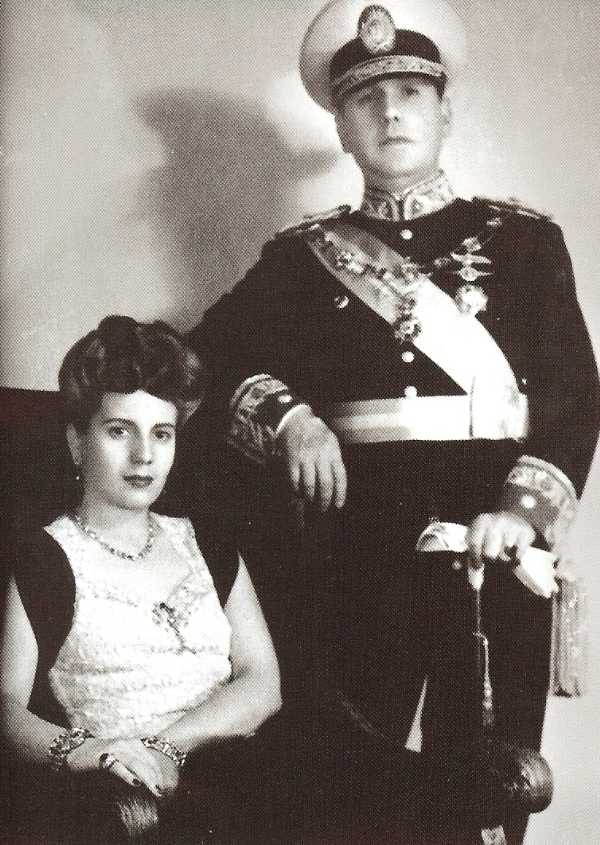
Publications of the Museo Evita, Buenos Aires
Presidential portrait - Juan & Eva Peron
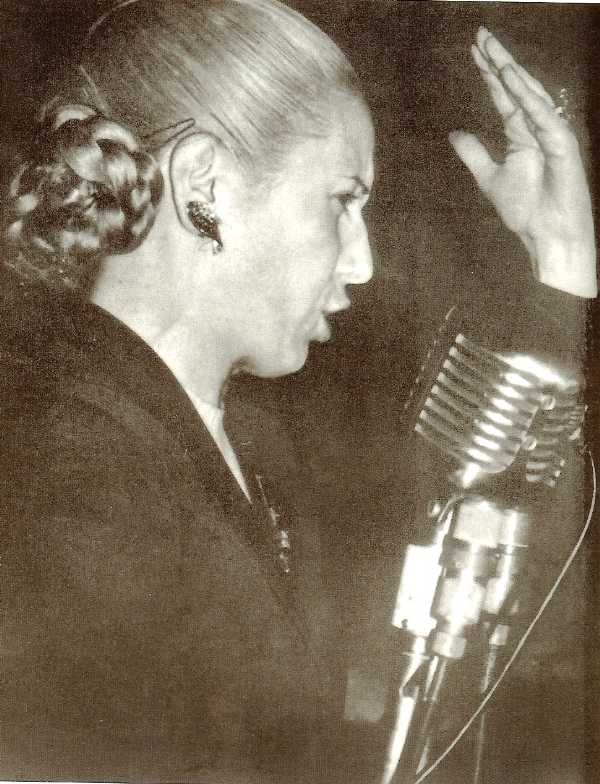
Publications of the Museo Evita, Buenos Aires
Evita speaking to the Descamisados
Eva Perón, A Powerful Champion of the Dispossessed and of Women
2008-08-18 16:57:22.000
Few women in politics has been as controversial as Maria Eva Duarte de Perón (1919-1952) of Argentina ? known to history as Evita. During her relatively short life (she died of cancer at the age of 33), she accomplished more than most women ever dreamed of doing. From humble beginnings, she fashioned herself as an accomplished actress, radio personality, cover girl, and union organizer.
From 1943 to 1945, she developed a radio series on biographies of illustrious women. Later she wrote, ?I would like the name of ?Evita? to figure somewhere in the history of my country.? Was this pure coincidence?
When she met Juan Domingo Perón at a benefit for earthquake victims in 1944, she was twenty-six years old and had been self-supporting for ten years; he was minister of labor in the military government and was nearly twice her age. In 1946 Juan Perón was elected president of Argentina in free elections, championing the cause of ?justicialismo? (social justice) and Eva Perón took her place at his side as First Lady. She became the first presidential spouse to be portrayed in the official presidential portrait ? and symbolically, she ? not he ? is depicted seated in the presidential chair while he stands at her side. She intended to stand beside her husband, not behind him. This was unprecedented!
The Museo Evita [Eva Peron Museum] in Buenos Aires opened in 2002 with support from the national government of Argentina This museum is committed to tell Eva?s story from the perspective of her achievements in social action, within the historical context of the period and to document the facts behind the myth of Evita. The affiliated research institute collects documentation, oral history interviews, and memorabilia, including many of Evita?s dresses and personal possessions. Both are housed in an exquisitely beautiful mansion, in the fashionable Recoleto district of Buenos Aires, which Eva Perón?s Foundation acquired in the 1940s and turned into a women?s shelter, much to the dismay of snobbish wealthy neighbors. Clio recently had the privilege of touring this museum. This is what Clio learned.
As First Lady, Eva took up the cause of women, children, the elderly, the ?descamisados? (shirtless ones) of the working class. Following a successful campaign to give Argentine women the vote and full citizenship in 1947, she founded a women?s political party, the Partida Peronista Feminino. With her foundation, housed in the ministry of labor and social welfare, she served her people by creating a spectacular (though short-lived) system of social assistance: schools, toys and vacation camps for poor children, maternity clinics, an institute for training women as nurses, shelters for homeless or destitute women and children. She sponsored employment opportunities, housing, health care, education, and homes for the elderly. She advocated a salary for married women and mothers ? to provide these women with ?an income of her own apart from what the man wishes to give her.? She worked long days and into the nights; her door was always open to those in need. In consequence, the workers and trade-unionists began to view her as the heart and soul of the nation, spinning out the myth of ?Evita? which grew to major proportions following her untimely death from cancer in 1952. Millions of Argentines, women and men, turned out for her funeral.
Evita insisted in her autobiographical memoir, La Razón de Mi Vida (The Mission of My Life), that Juan Domingo Perón had shown her the way to her feminist path, but hers was a womanly feminist path, what Clio would call ?relational.? Both she and Juan rejected the notion that women should aspire to be like men. Both believed in the complementarity of the sexes and their distinctive, separate roles. Both thought that married women should not have to work for pay outside their homes. This was undoubtedly the dominant view in the 1940s and 1950s, but it did not preclude a feminist agenda.
In this memoir, published after her death, Evita presented her perspectives on many issues. Here are a few excerpts that Clio found especially memorable:
?A man of action is one who triumphs over all the rest. A woman of action is one who triumphs for the rest. Isn?t this a great difference??
?Everything, absolutely everything in our contemporary world has been tailored to the measure of men. We [women] are absent from governments. We are absent from Parliaments. From international organizations. We are neither in the Vatican nor in the Kremlin. We are not part of the upper echelons of the imperialist countries. We are not in the atomic energy commissions. Nor in the great multinational corporations. Nor in freemasonry nor in any secret societies. We are not in any of the great power centers of the world.?
?? it is well to remember that Perón is not only President of the Republic, he is also the Leader of his people. This is a fundamental condition, and is directly related to my decision to handle the role of wife of the President of the Republic in a manner different from any President?s wife who had preceded me. . . .?
?I was not only the wife of the President of the Republic, I was also the wife of the Leader of the Argentines.
?I had to have a double personality to correspond with Perón?s double personality. One, Eva Perón, wife of the President, whose work is simple and agreeable, a holiday job of receiving honors, of gala performances; the other, ?Evita,? wife of the Leader of a people who have placed all their faith in him, all their hope and all their love.
?A few days of the year I act the part of Eva Perón; and I think I do better each time in that part, for it seems to me to be neither difficult nor disagreeable.
?The immense majority of days I am, on the other hand, ?Evita,? a link stretched between the hopes of the people and the fulfilling hands of Peron, Argentina?s first woman Peronista ? and this indeed is a difficult role for me, and one in which I am never quite satisfied with myself.?
?The entire nation ends at the door of our home, and other laws and other rights begin . . . the law and the rights of man ? who very often is only a master, and also, at times, a dictator. And nobody can interfere there.?
?The mother of a family is left out of all security measures. She is the only worker in the world without a salary, or a guarantee, or limited working hours, or free Sundays, or holidays, or any rest, or indemnity for dismissal, or strikes of any kind. All that, we learned as girls, belongs to the sphere of love . . . but the trouble is that after marriage, love often flies out of the window, and there everything becomes ?forced labor? . . . obligations without any rights! Free service in exchange for pain and sacrifice.?
?. . . the vote is its [the feminist movement?s] most powerful instrument, and with it we women of all the world have to win all our rights . . . or, rather, the great right of being simply women, and thus being able to fulfill, totally and absolutely, the mission that, as women, we have to perform for humanity. . . we cannot ever forget . . . that the vote, that is to say, ?politics,? is not an end but a means.?
What are your thoughts about powerful political activists like Evita?
Sources:
Evita Peron, Evita by Evita: Eva Duarte Peron Tells Her Own Story (London: Proteus, 1978; first published in 1953 as La Razón De Mi Vida [The Mission of my Life]). Quotes: pp. 63, 199, 223-24, 57-58, 184, 182.
Museo Evita (Catalogue), coordinated by Pablo Vaca (Buenos Aires: Asociación Museo Evita, 2007).
Further reading:
J. M. Taylor, Eva Peron: The Myths of a Woman (University of Chicago Press, 1979).
Marysa Navarro, Evita (Buenos Aires: Edhasa, rev. ed. 2005).
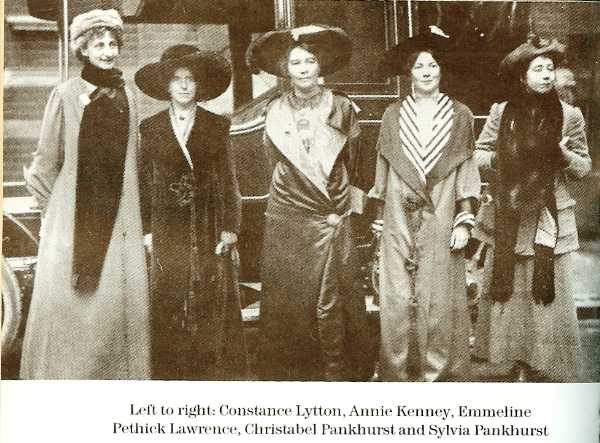
Constance Lytton, Prisons & Prisoners (1914)
Lady Constance Lytton, Annie Kenney, Emmeline Pethick Lawrence, Christabel Pankhurst, Sylvia Pankhurst - all of the Women's Social and Political Union
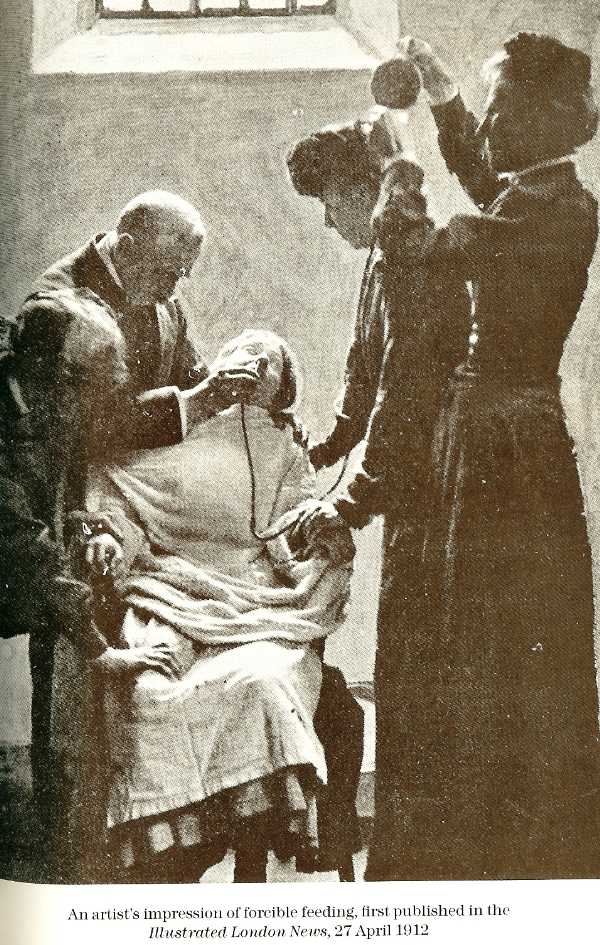
Constance Lytton, Prisons & Prisoners (1914)
Artist's impression of forcible feeding, 1912, from Illustrated London News, 27 April 1912
Clio commemorates an English suffragette, Constance Lytton
2008-08-09 12:47:40.000
Women?s campaign for the vote in England ranks as one of the most hard-fought of all time. Many groups and factions participated, but the most militant was the Women?s Social and Political Union, known as the WSPU, founded in 1903 by Emmeline Pankhurst and her daughters. The WSPU attracted a huge number of supporters from every social class and developed a philosophy of militant non-violence that was highly admired by Gandhi.
One of the more improbable militants was Lady Constance Lytton (1863-1923). A genteel aristocrat, she grew up in a family of highly-placed diplomats; her father had served as Viceroy of India and her brother held a seat in the House of Lords. Her mother became a Lady-in-Waiting to Queen Victoria.
Yet Constance, often sickly and unmarried into her 30s, lived a sheltered existence in the countryside. She became keenly interested in the plight of women of the lower classes, women prisoners, and others who she felt were victimized by English society in its current form. Sympathizing with animals, she also became a vegetarian.
At the age of 40, after many internal struggles and questioning, Constance joined the campaign for woman suffrage, becoming a ?foot soldier? in the WSPU. At one point she disguised herself as a woman worker, alias Jane Warton, and was arrested and force-fed eight times before the authorities discovered her real identity and released her.
In fragile health, Lytton became half-paralyzed following a serious heart attack in 1912 and learned to write again with her left hand. She then began writing her memoirs of her suffrage activities. In this selection, composed during the climactic years of the militant suffrage campaign, Constance Lytton describes the moment in which she became conscious of women?s plight and determined to fight for the political representation of all women.
?During my stay at Littlehampton I witnessed a scene which produced a great impression upon my conscience. One morning, while wandering through the little town, I came on a crowd. All kinds of people were forming a ring round a sheep which had escaped as it was being taken to the slaughterhouse. It looked old and misshapen. A vision suddenly rose in my mind of what it should have been on its native mountain-side with all its forces rightly developed, vigorous and independent. There was a hideous contrast between that vision and the thing in the crowd.
?With growing fear and distress the sheep ran about more clumsily and became a source of amusement to the onlookers, who laughed and jeered at it. At last it was caught by its two gaolers, and as they carried it away one of them, resenting its struggles, gave it a great cuff in the face. At that I felt exasperated. I went up to the men and said, ?Don?t you know your own business.? The men seemed ashamed, they adjusted their hold more efficiently and the crowd slunk away.
?From my babyhood I have felt a burning indignation against unkindness to animals, and in their defense I have sometimes acted with a courage not natural to me. But on seeing this sheep it seemed to reveal to me for the first time the position of women throughout the world. I realised how often women are held in contempt as beings outside the pale of human dignity, excluded or confined, laughed at and insulted because of conditions in themselves for which they are not responsible, but which are due to fundamental injustices with regard to them, and to the mistakes of a civilisation in the shaping of which they have had no free share. I was ashamed to remember that although my sympathy had been spontaneous with regard to the wrongs of animals, of children, of men and women who belonged to down-trodden races or classes of society, yet that hitherto I had been blind to the sufferings peculiar to women as such, which are endured by women of every class, every race, every nationality, and that although nearly all the great thinkers and teachers of humanity have preached sex-equality, women have no champions among the various accepted political or moral laws which serve to mould public opinion of the present day.?
Clio wonders how many of you have experienced such a moment of awakening and unnatural courage. What has it led you to do? Clio welcomes your comments.
Source: Constance Lytton and Jane Warton, spinster. Prisons & Prisoners: Some Personal Experiences (London: Heinemann, 1914; reissued by Virago Press, 1988, with a new introduction by Midge Mackenzie), pp. 12-14.
Further Reading: Midge Mackenzie, Shoulder to Shoulder: A Documentary. The Stirring History of the Militant Suffragettes: The Voices, the Faces, the Deeds, the Memories, the Personal Testimony of the Remarkable Women Who Fought ? and Won ? the Battle for the Vote (New York: Knopf, 1975; reissued by Random House, 1988) ; June Purvis, Emmeline Pankhurst: A Biography (London & New York: Routledge, 2002).

